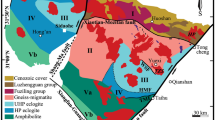Abstract
Lake Vostok, the largest subglacial lake in Antarctica, is covered by the East Antarctic ice sheet, which varies in thickness between 3,750 and 4,100 m (ref. 1). At a depth of 3,539 m in the drill hole at Vostok station, sharp changes in stable isotopes and the gas content of the ice delineate the boundary between glacier ice and ice accreted through re-freezing of lake water2. Unlike most gases, helium can be incorporated into the crystal structure of ice during freezing3, making helium isotopes in the accreted ice a valuable source of information on lake environment. Here we present helium isotope measurements from the deep section of the Vostok ice core that encompasses the boundary between the glacier ice and accreted ice, showing that the accreted ice is enriched by a helium source with a radiogenic isotope signature typical of an old continental province. This result rules out any significant hydrothermal energy input into the lake from high-enthalpy mantle processes, which would be expected to produce a much higher 3He/4He ratio. Based on the average helium flux for continental areas, the helium budget of the lake leads to a renewal time of the lake of the order of 5,000 years.
This is a preview of subscription content, access via your institution
Access options
Subscribe to this journal
Receive 51 print issues and online access
$199.00 per year
only $3.90 per issue
Buy this article
- Purchase on Springer Link
- Instant access to full article PDF
Prices may be subject to local taxes which are calculated during checkout

Similar content being viewed by others
References
Kapitsa, A. P., Ridley, J. K., Robin, G. Q., Siegert, M. J. & Zotikov, I. A. A large deep freshwater lake beneath the ice of central East Antarctica. Nature 381, 684–686 (1996).
Jouzel, J. et al. More than 200 meters of lake ice above subglacial lake Vostok, Antarctica. Science 286, 2138–2141 (1999).
Haas, J., Bullemer, B. & Kahane, A. Diffusion de l'hélium dans la glace monocristalline. Solid State Commun. 9, 2033–2035 (1971).
Jean-Baptiste, P., Raynaud, D., Mantisi, F., Sowers, T. & Barkov, N. Measurement of helium isotopes in Antarctic ice: preliminary results from Vostok. CR Acad. Sci. Paris 316, 491–497 (1993).
Craig, H. & Chou, C. C. Helium isotopes and gases in Dye 3 ice cores. Eos 63, 298 (1982).
Craig, H. in Abstr. Int. Conf. On Stable Isotopes and Isotope Effects (eds Soulié, E. & Roth, E.) 1–112 (Commissariat à l'Energie Atomique, Paris, 1999).
Andrews, J. N. The isotopic composition of radiogenic helium and its use to study groundwater movement in confined aquifers. Chem. Geol. 49, 339–351 (1985).
Mamyrin, B. A. & Tolstikhin, I. N. Helium Isotopes in Nature (Elsevier, Amsterdam, 1984).
Craig, H. & Lupton, J. E. Primordial neon, helium and hydrogen in oceanic basalts. Earth Planet. Sci. Lett. 31, 369–385 (1976).
Farley, K. A. & Neroda, E. Noble gases in the Earth's mantle. Annu. Rev. Earth Planet. Sci. 26, 189–218 (1998).
Siegert, M. J., Kwok, R., Mayer, C. & Hubbard, B. Water exchange between the subglacial Lake Vostok and the overlying ice sheet. Nature 403, 643–646 (2000).
Souchez, R., Petit, J. R., Tison, J. L., Jouzel, J. & Verbeke, V. Ice formation in subglacial Lake Vostok, Central Antarctica. Earth Planet. Sci. Lett. 181, 529–538 (2000).
Savvin, A., Greve, R., Calov, R., Mugge, B. & Hutter, K. Simulation of the Antarctic ice sheet with a three-dimensional polythermal ice-sheet model, in support of the EPICA project. II. Nested high resolution treatment of Dronning Maud Land, Antarctica. Ann. Glaciol. 30, 69–75 (2000).
O'Nions, R. K. & Oxburgh, E. R. Heat and helium in the earth. Nature 306, 429–431 (1983).
Craig, H., Lupton, J. E., Welhan, J. A. & Poreda, R. Helium isotope ratios in Yellowstone and Lassen Park volcanic gases. Geophys. Res. Lett. 5, 897–900 (1978).
Hooker, P. J., Bertrami, R., Lombardi, S., O'Nions, R. K. & Oxburgh, E. R. Helium-3 anomalies and crust-mantle interaction in Italy. Geochim. Cosmochim. Acta 49, 2505–2513 (1985).
Davy, J. G. & Miller, K. W. The diffusion of helium through ice. Solid State Commun. 3, 1459–1461 (1970).
Jones, S. J. Diffusion of helium in ice. Phys. Canada 27, 60–61 (1971).
Siegert, M. J. Antarctic subglacial lakes. Earth Sci. Rev. 50, 29–50 (2000).
Salamatin, A., Vostretsov, R. N., Petit, J. R., Lipenkov, V. Y. & Barkov, N. I. Geophysical and paleoclimatic implications of the temperature profile from the deep borehole at Vostok station (Antarctica). Data Glaciol. Stud. 85, 233–240 (1998).
Jean-Baptiste, P., Mantisi, F., Dapoigny, A. & Stievenard, M. Design and performance of a mass spectrometric facility for measuring helium isotopes in natural waters and for low-level tritium determination by the 3He ingrowth method. Appl. Radiat. Isot. 43, 881–891 (1992).
Acknowledgements
Vostok is a joint project between Russia, France and the USA. We thank the Russian Antarctic Expedition for station and drilling-operation support, and the IFRTP (Institut Français de Recherche et Technologies Polaires) and the NSF Office of Polar Program for logistic support. The project was supported in Russia by the Russian Ministry of Sciences, and in France by CNRS and CEA. We thank A. Salamatin, P. Duval and J. Meyssonnier for discussions.
Author information
Authors and Affiliations
Corresponding author
Rights and permissions
About this article
Cite this article
Jean-Baptiste, P., Petit, JR., Lipenkov, V. et al. Constraints on hydrothermal processes and water exchange in Lake Vostok from helium isotopes. Nature 411, 460–462 (2001). https://doi.org/10.1038/35078045
Received:
Accepted:
Issue Date:
DOI: https://doi.org/10.1038/35078045
This article is cited by
Comments
By submitting a comment you agree to abide by our Terms and Community Guidelines. If you find something abusive or that does not comply with our terms or guidelines please flag it as inappropriate.



